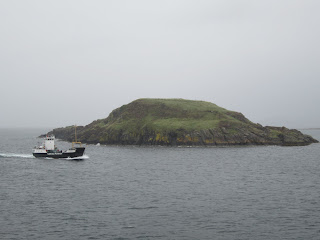 |
| The way to Mull |
Or something like that.
Mull is actually quite a large island, and we mainly experienced it from the one and a half hour guided bus trip from one side to the other. Part of the reason it took so long is because the island is quite underdeveloped, and its roads are mainly single lane, which meant we had to stop and let all the cars coming the other way past. The scenery, however, was spectacular, with mountains, glens and lochs everywhere you look. Unfortunately it was streaming with rain, which makes the already shitty photos from a bus even shittier, so I didn't bother. I quite enjoyed it actually - it made me remember that I wasn't there to sit behind a lens and enjoy my holiday when I got home - I was there to enjoy it then.
On the other end of Mull we arrived at the port where the ferry would take us to the tiny island of Staffa.
I noticed that the ferries I was encountering were getting progressively smaller. The one that took me to Scotland was very big, the one that took me to Mull was large, and now I saw one waiting at the dock that was merely average. This ferry, however, was intended for Iona, the island that lay within spitting distance of this point. I, however, was going to Staffa first, and the boat that came bouncing over the choppy water to take me there was tiny by ferry standards.
The Atlantic swell is truly a thing to behold, and experiencing it in such a small boat you'd better have a strong stomach. It was only after passing over the first handful of swells that I realized there was a definite chance I would not drown, as the boat passed over them confidently (albeit startlingly).
 |
| Isle of Staffa |
This place was too harcore even for monks to settle. I think I've mentioned before that monks in the middle ages liked to punish themselves by building monastaries and churches in the nastiest, most inhospitable places they could find. The only signs of settlement on Staffa, however, is a single stone wall - presumably where someone started building a house and then realised what a stupid idea it was and gave up.
 |
| Iona Abbey |
Iona is a much friendlier place, which would make anyone that's visited it but not Staffa wonder about my sanity. In the 6th century Saint Columba, who was a quite well-off statesman from Ireland, traveled to this speck of rock to set up a monastary and bring Christianity to Scotland. This is where the famous Iona Abbey is. The place slowly became a popular place for pilgrims (because they like to punish themselves almost as much as monks), but when the reformation brought protestantism to Scotland the place was abandoned and slowly fell into disrepair. Eventually in the early 19th century the Duke of Argyll bought the place because he recognized its significance and ever since restoration has been going on in the monastary and church.
Just down the way there is also a nunnery, built later but also abandoned during the reformation and never restored (though effort is put into preservation).
I have to wonder if having a nunnery in such close proximity to a monastary resulted in a miraculous amount of virgin births on the island... (as if one isn't miraculous already)

"it made me remember that I wasn't there to sit behind a lens and enjoy my holiday when I got home - I was there to enjoy it then". Exactly! said!
ReplyDeleteWhat great places to visit - would have liked to have been there with you!